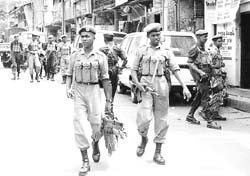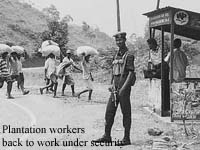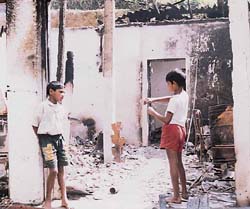Special Report
5th November 2000Heal the hills
News/Comment|
Plus| Business| Sports|
Sports Plus| Mirror Magazine

HRC blasts police, calls for stern action
By Christopher Kamalendran and Nilika de Silva
Fourteen years of peaceful co-existence between the Sinhalese and Tamil people in the upcountry region was blasted in a day, leaving the unanswered question what went wrong? Can the violence, which rocked the hill country, be attributed to the very same people who lived together through thick and thin? "Even
when the Dalada Maligawa, the most sacred religious shrine for Buddhists
was attacked, the people were not aroused and there was no backlash," Ven.
Middeniye Soratha Thera of the Talawakele, Sri Saddharmaramaya temple said.
"Even
when the Dalada Maligawa, the most sacred religious shrine for Buddhists
was attacked, the people were not aroused and there was no backlash," Ven.
Middeniye Soratha Thera of the Talawakele, Sri Saddharmaramaya temple said.
"This time too as in the 1983 communal violence, there were many instances where Tamils protected the Sinhalese and Sinhalese the Tamils," he said.
Even Tamil people participate in religious activities of the temple, the priest said, emphasising that the problem was not between the ethnic groups, but that the people were being used to create violence.
Many villagers believe the violence was orchestrated by interested parties.
"This could not have been a spontaneous reaction to the tragedy at Bindunuwewa," Kapila a trader at Talawakelle said pointing out that the violence in the hill country erupted a full five days after the Bindunuwewa massacre.
Last Sunday, estate trade unions led by P. Chandrasekeran organised a rally in protest against the massacre at the rehabilitation centre. It was held to coincide with the funeral of a Bindunuwewa victim from the area.
After the meeting groups of plantation workers took to the streets breaking into and setting fire to shops . There was retaliation and the situation got out of control as the Police looked on .
 Looting
and burning went on even though a curfew was imposed while provocative
posters some of them supporting the LTTE appeared in some areas.
Looting
and burning went on even though a curfew was imposed while provocative
posters some of them supporting the LTTE appeared in some areas.
"If the Police had fired one canister of tear gas the situation could have been contained," Ven. Soratha Thera said.
He said he then contacted the Malwatte Maha Nayake and told him the situation was bad. The Maha Nayake called the President and troops were despatched.
"I believe this violence was provoked by a group of youths who came from Colombo for Deepavali," Ven. Soratha Thera said.
In Ginigathhena the line of shops which caught fire included premises belonging to both communities. The fire broke out in one shop and spread to others at a time of curfew.
One resident said he saw a bus laden with weapons and many felt police inaction had allowed the situation to get out of control. As a result the officer in charge of the Ginigathhane police station was transferred.
 Trees
were cut to block the roads and apparently prevent troops from moving in.
Telephone lines were also cut.
Trees
were cut to block the roads and apparently prevent troops from moving in.
Telephone lines were also cut.
The massacre at Bindunuwewa on October 25, was followed by an allegedly orchestrated backlash in Talawakele, Aggrapatana and environs on Sunday and Ginigathhena on Monday.
When we visited the area on Thursday, the tea estates lay deserted and the roads empty. On any other day the tea pluckers would set forth to work at 5.30 a.m.But that day even by 8.30 in the morning, there was little activity.
People appeared to be equally non-resilient as the services, in getting back into the regular rhythm of life. The transport services had only been partially restored but buses on many routes could not be operated as roads were damaged in a week of violence .
Schoolchildren were seen at bus stops, waiting for buses that would not come. Schools which reopened after a week, closed early — around 10 a.m. — as only a few teachers and students had turned up.
In Hatton, parents were still hesitant to send their children to school or work as they feared more trouble.
There were no signs of any violence and the authorities claimed the situation had been brought under control. But in reality the situation was crawling back to normalcy, carrying with it the scars of violence and a cry for security.
A vehicle carrying journalists from our sister paper the Lankadeepa was stopped by a mob at Boralanda. They smashed up the windscreen while the journalists took cover. At Sri Saddharmara-maya temple in Talawakelle more than hundred people sought safety on Sunday night. All but 15 have now left to stay with relatives or friends.
Muthumenike a mother of three was among those remaining in the temple. "This is the third time this has happened to us," said Muthumenike sobbing. "Our house was set on fire while we were sleeping."
Overall both communities suffered in this senseless destruction. The
question is who gained what from it?
Back to work Ending
a five day long boycott by estate workers, the Ceylon Workers Congress
and the Up-country Peoples Front, the two main trade unions in the estate
sector have appealed to its members to return to work. Ending
a five day long boycott by estate workers, the Ceylon Workers Congress
and the Up-country Peoples Front, the two main trade unions in the estate
sector have appealed to its members to return to work.
The strike was called off as the Government promised to release Up-country Peoples Front(UPF) leader P. Chandrasekeran who had been questioned by the CID for more than 5 days. Meanwhile because of the strike tea production had been neglected resulting in massive losses to tea companies. Tea a major agricultural revenue earner, depends largely on the right timing for plucking. However, the upheaval in the hills saw tea shoots growing to treble their usual length and the wastage which followed, cost many tea estates losses running into millions of rupees. "Even when work resumes initially there will be a loss in quality," Ceylon Tea Plantation Exports Managing Director, Dayan Peiris said. |
Troops stay onTroops will stay on in Nuwara Eliya in the wake of recent disturbances while the Government launches multi-million rupee rehabilitation and reconstruction projects, Government Agent Dhanasena Hettiaratchi said yesterday. On a directive from the Presidential Secretariat, a two-member team is assessing the damage caused by several days of violence, Mr. Hettiarachchi said. The GA was summoned to Colombo on Friday for a briefing on rehabilitation programmes. The GA said that at least 800 persons had been displaced in Talawakelle alone and that troops would remain in the area until the security situation improved. Mr. Hettiarachchi said life in the district was returning to normal and he hoped all work would resume from tomorrow. Meanwhile the area has been hit by a shortage of some food stuffs, mainly due to the breakdown of train services. Work on tea estates — a key factor in the country's economy — was also badly hit by the disturbances. |
HRC blasts police, calls for stern action
The Human Rights Commission investigating the massacre at the Bindunuwewa Rehabilitation Centre has charged that police negligence had led to the tragedy.In an 18 page Interim Report released on Wednesday the Human Rights Commission called for stern action against the respective police officers.
"From all the information that we received in the course of our inquiry it is clear that the police officers, approximately 60 in number, have been guilty of a grave dereliction of duty in not taking any effective action to prevent the acts of violence that resulted in the deaths of 26 inmates and injury to several other inmates of the Bindunuwewa camp," the report said.
"In any event the crowd that collected had not possessed any firearms and were armed only with knives, poles and other implements. The police on the other hand were fully armed and could have easily brought the crowd under control and dispersed it; at least some of the persons who were leading the crowd could have been arrested."
"On the October 24 the inmates had agitated for their release and had acted in an unruly manner. A small crowd of "villagers" had collected and the inmates and the crowd had thrown stones at each other. However by about 11.30 the situation had returned to normal," the report stated.
The Army which had arrived on a message from the Police had left around that time. According to the information supplied to us by the Police about 30 police officers had been left behind to guard the temple.
The report said that Bandarawela SSP had said that residents had complained against the continuance of the rehabilitation camp in Bindunuwewa. In 1998 there had been an exchange of correspondence between the SSP Bandarawela Police Division and the OIC of the centre in which issues regarding the security of the centre had been raised.
The SSP had stated that he was not in a position to provide additional security to the camp owing to a shortage of police cadres and had recommended that the centre be relocated. There is however no evidence of any agitation or collective protest against the camp or its inmates by the residents. However the incidents of October 24 suggest that the inmates were raising new demands and articulating them more aggressively.
The report cautioned that the role of Anton James reportedly an agitator should be fully investigated.
The HRC advocates the formulation of peace committees at the local level with the support of religious leaders and civil society organisations.
"The inmates of the Bindunuwewa Rehabilitation centre were all young persons sent to the centre on a rehabilitation order of the Defence Secretary. They included both suspects arrested under the PTA as well as persons who had surrendered voluntarily to escape the LTTE. Some of them were as young as 11 - 14 years.
"When we interviewed the two SSP we found that they were unaware that a large number of posters had appeared in Bandarawela town, allegedly on the night of the 24th inciting people to violence against the inmates and the rehabilitation camp," the report charged, adding, the posters provided a line of investigation which may lead to persons or organizations behind the attack .
A statement made by one of the suspects arrested, had identified and named some of the people who were responsible for the posters and identified those who instigated the violence and led the attack on the camp.
The report further said that all the information gathered did not suggest that what occurred on the 25th was an unpremeditated eruption of mob violence caused by the provocation of the inmates.
"It is more consistent with a premeditated planned attack," the report said.
The HRC Interim Report was signed by the Chairman HRC Faisz Mustapha , and Commissioners Godfrey Gunatilleke, Manouri Muttetuwagama, Sarath Cooray and N. Selvakumaran following a visit made to Bandarawela on October 27.








![]()
Front Page| News/Comment| Editorial/Opinion| Plus| Business| Sports| Sports Plus| Mirror Magazine
Please send your comments and suggestions on this web site to

